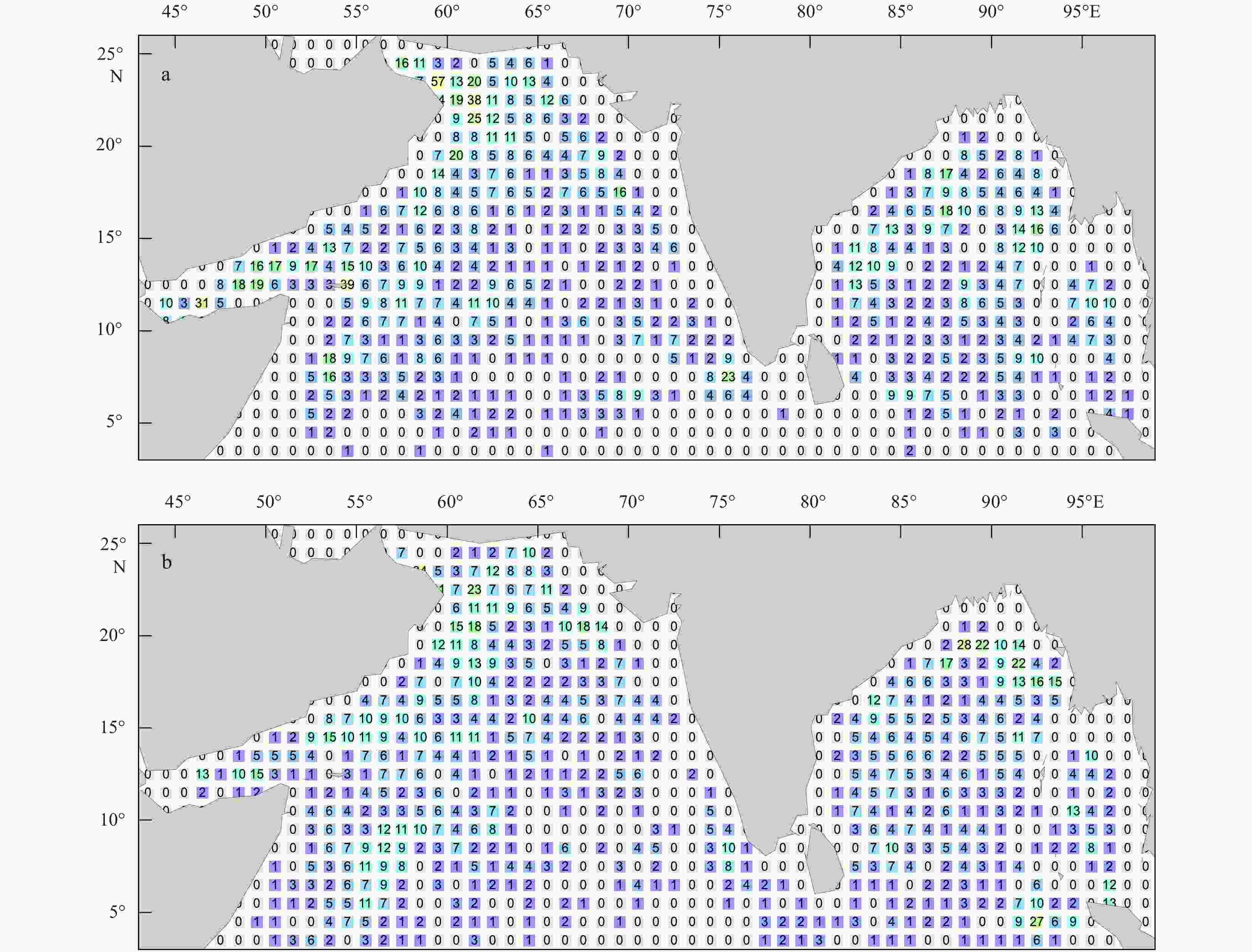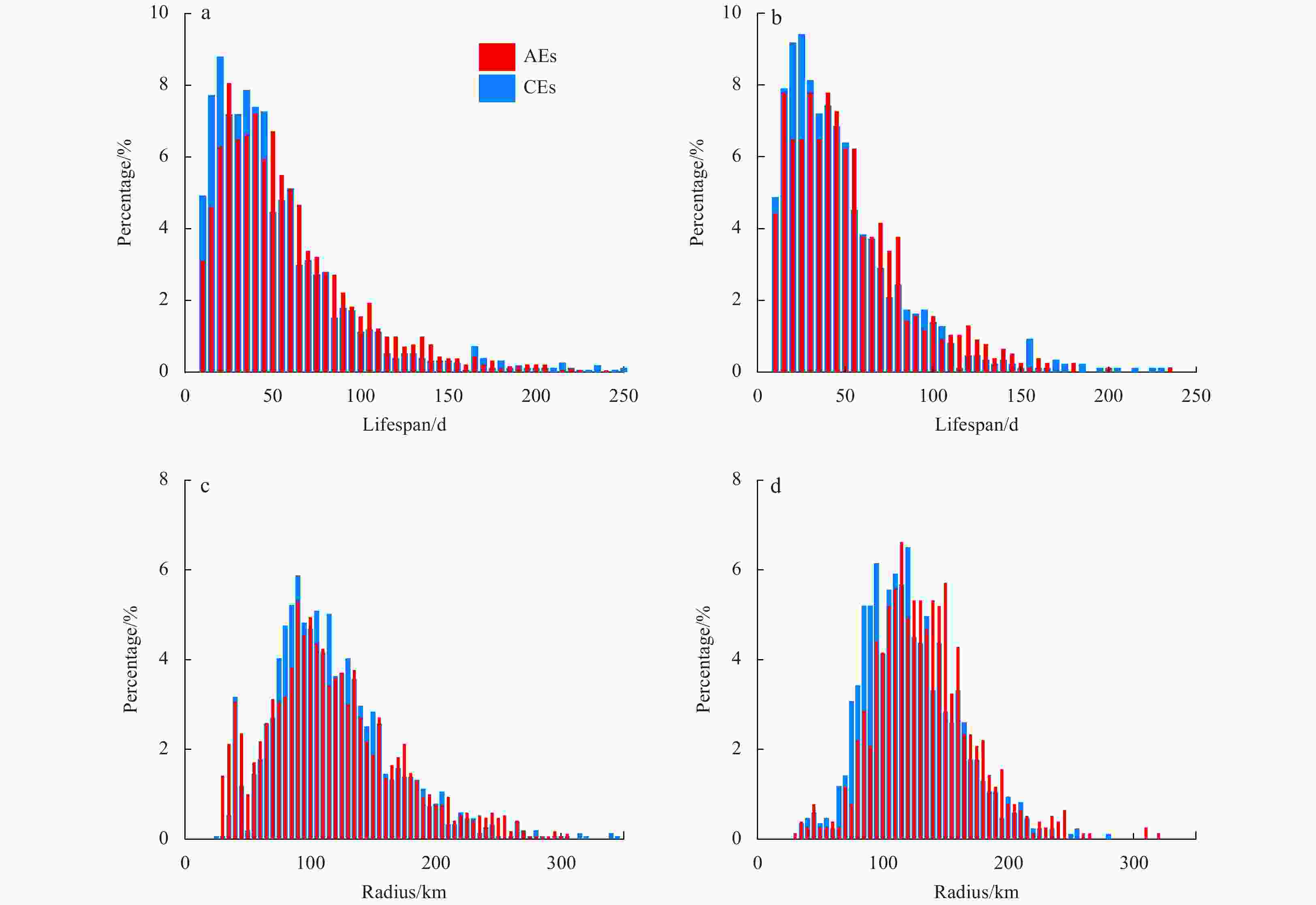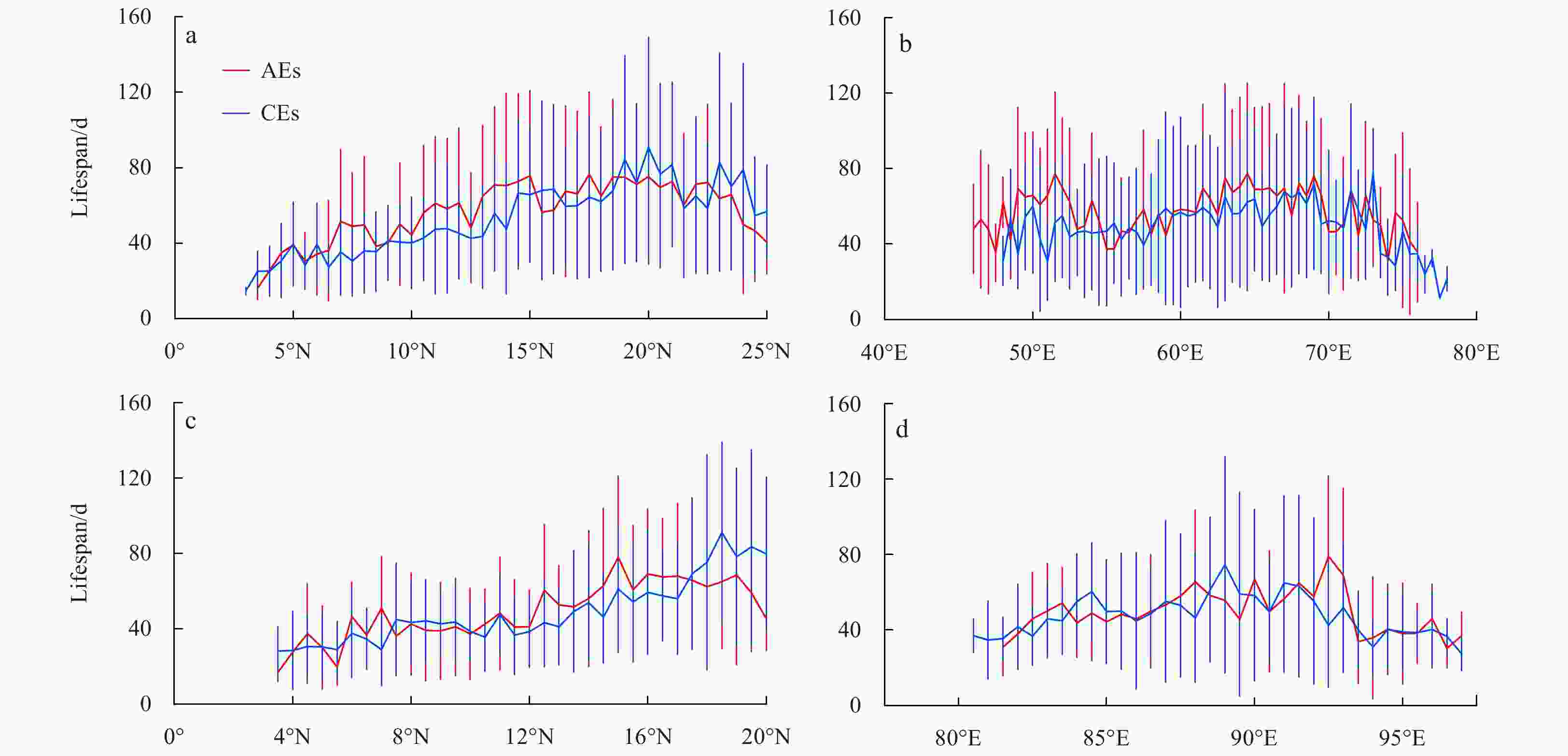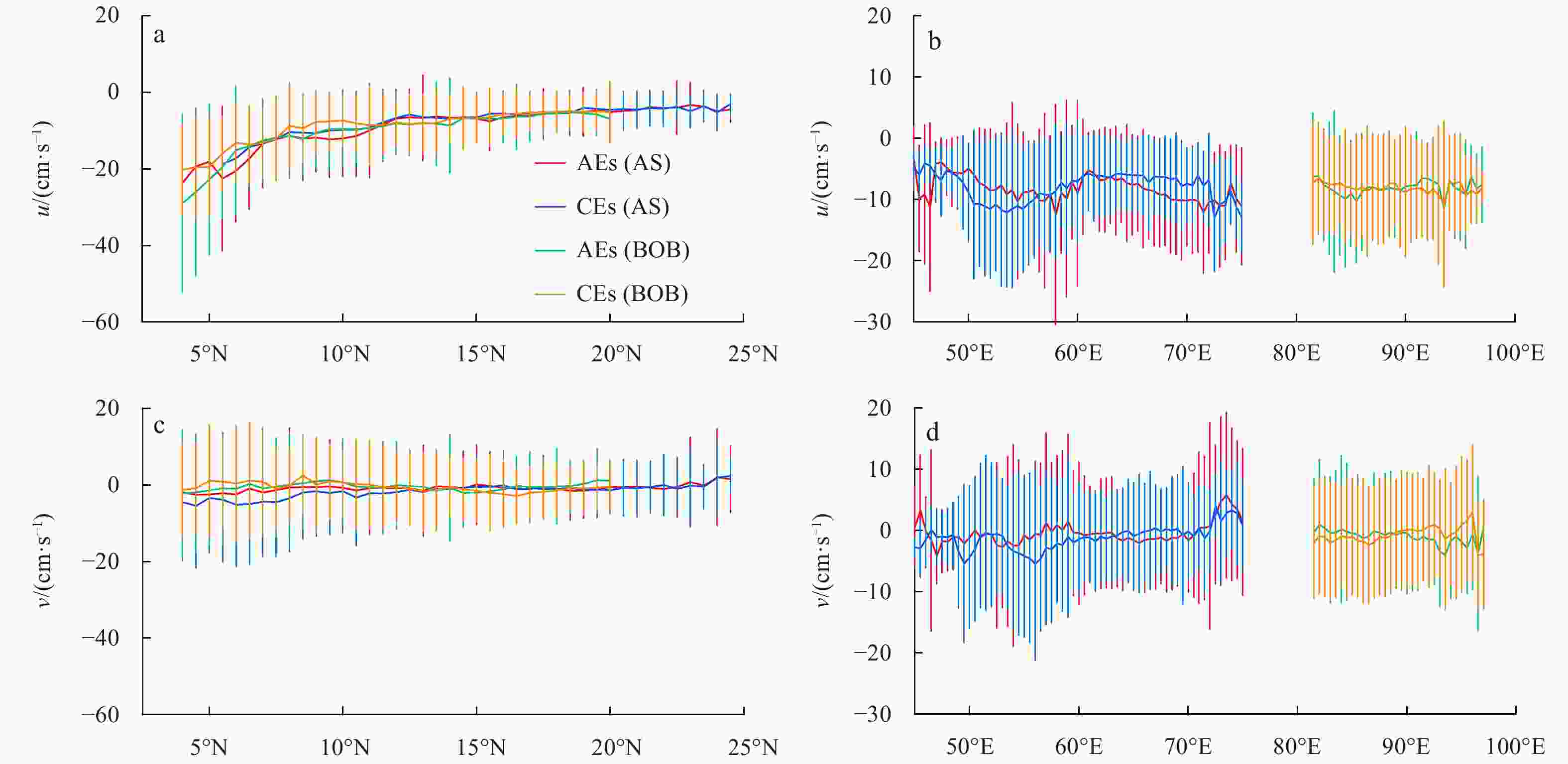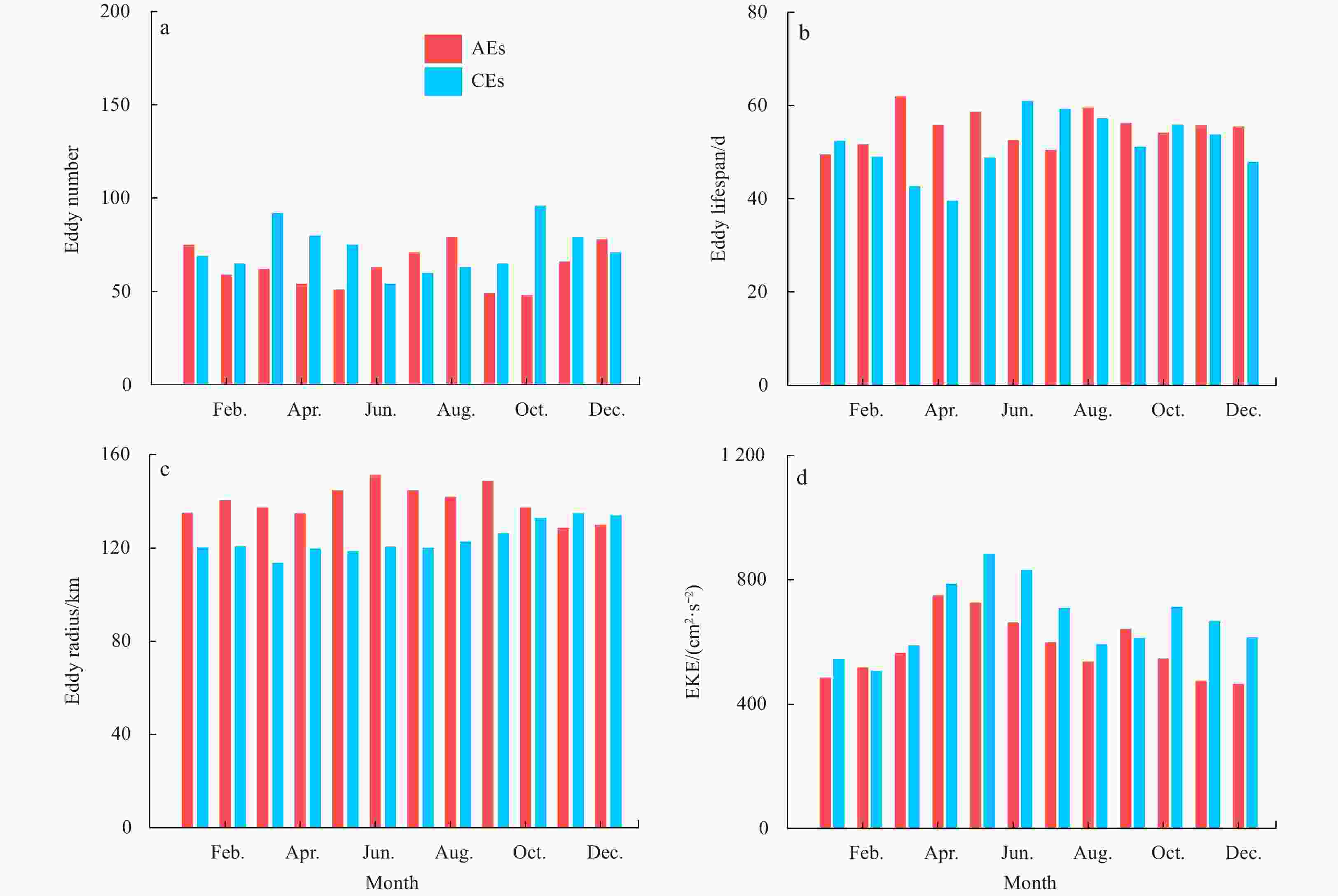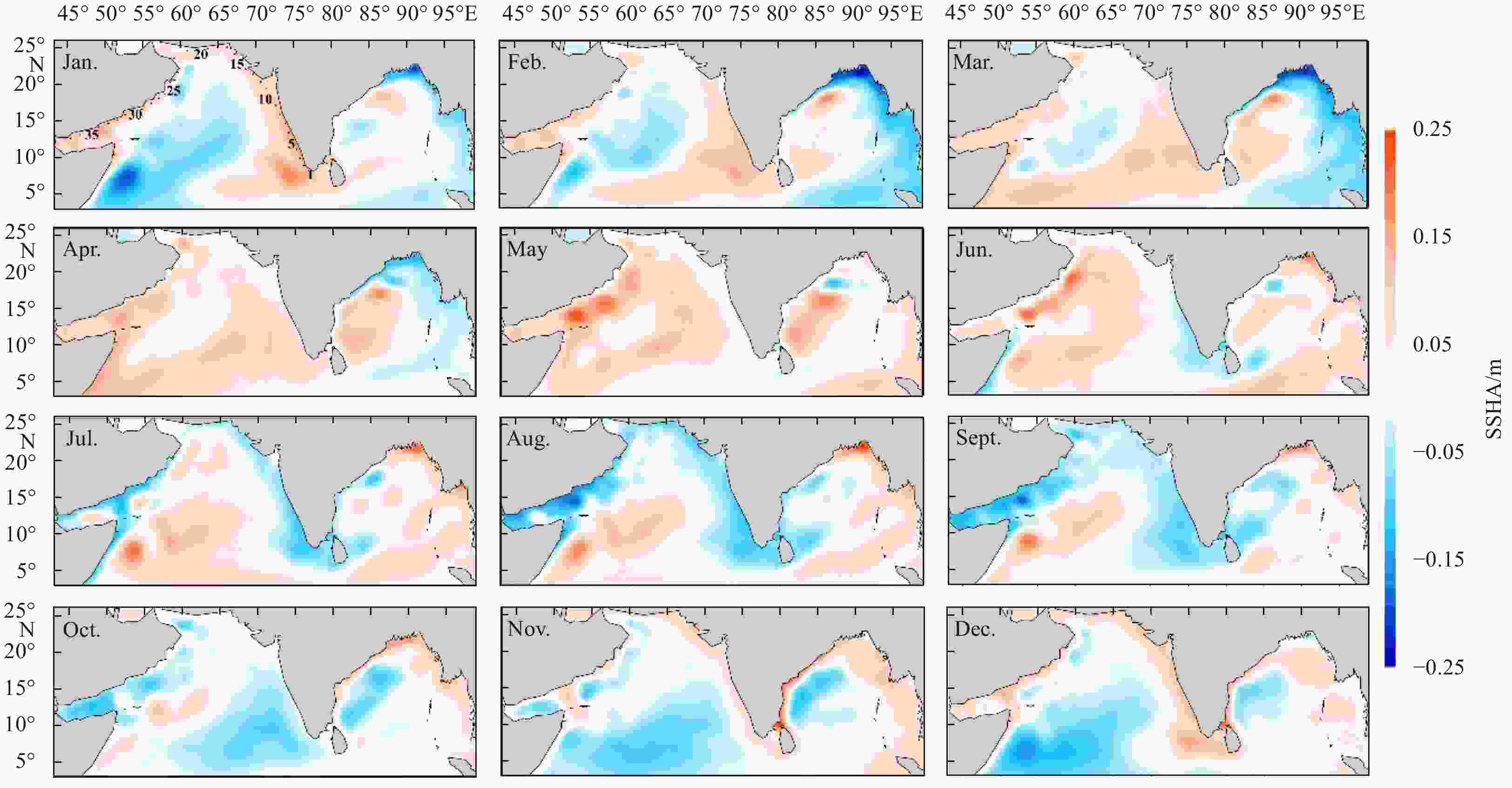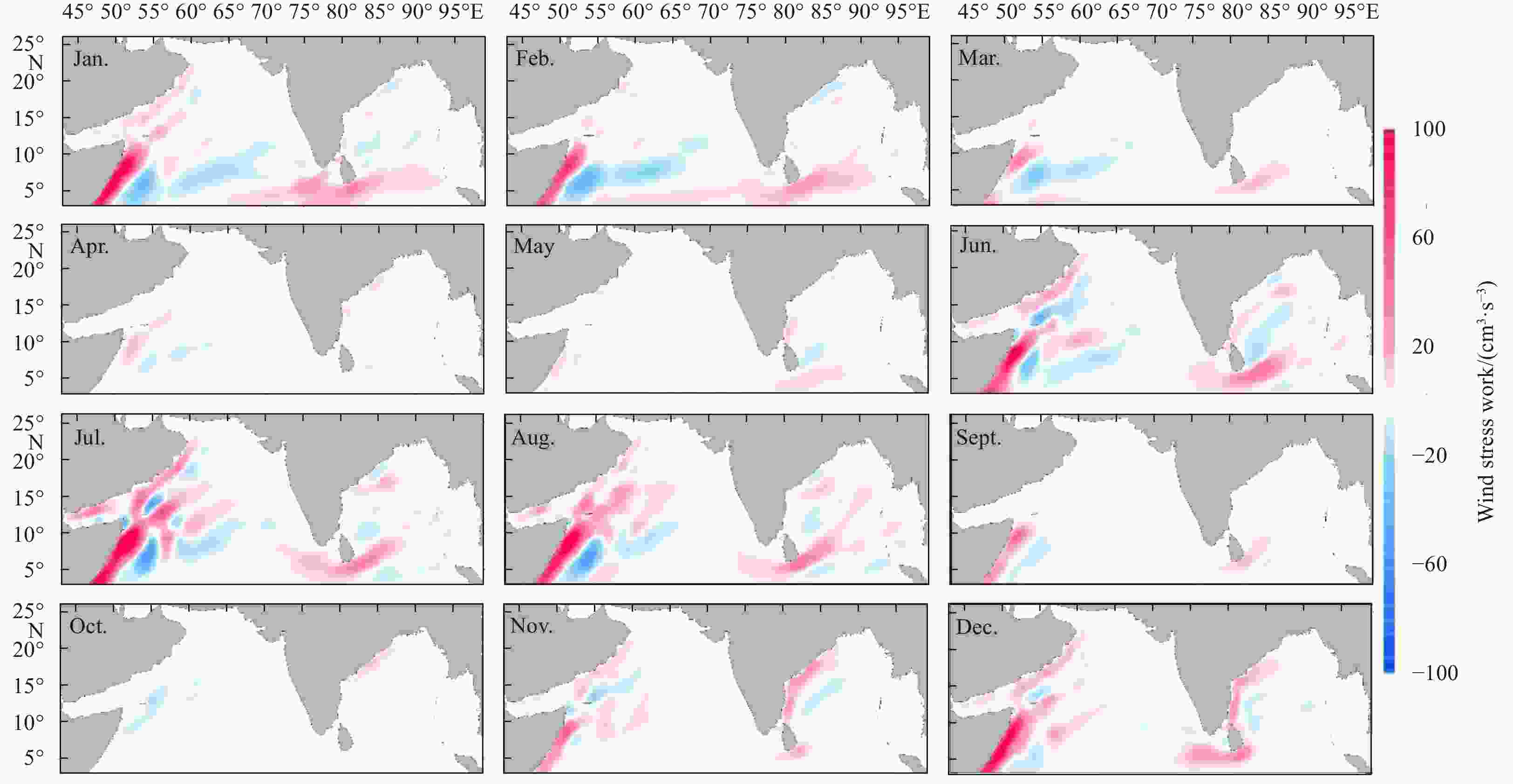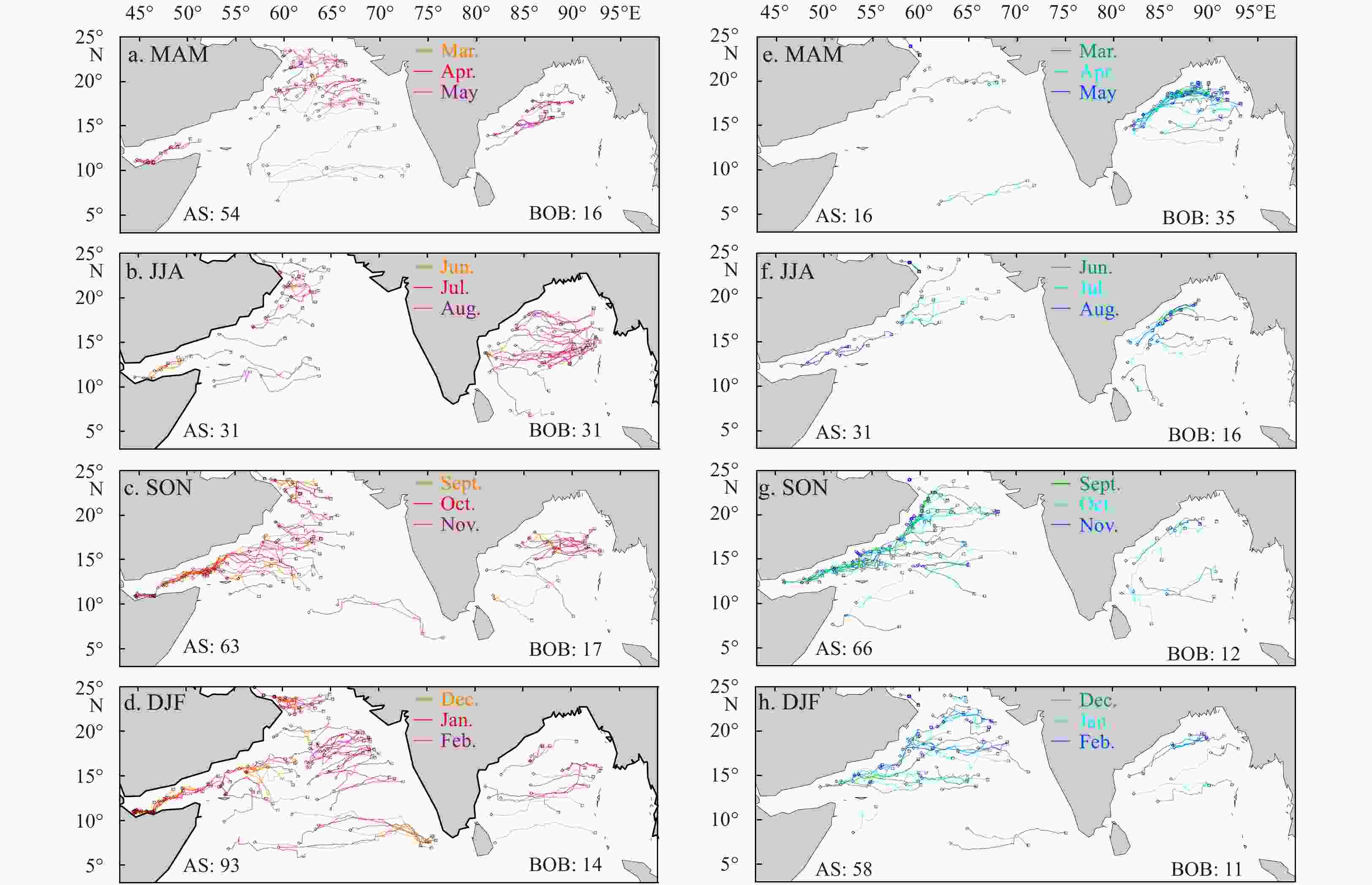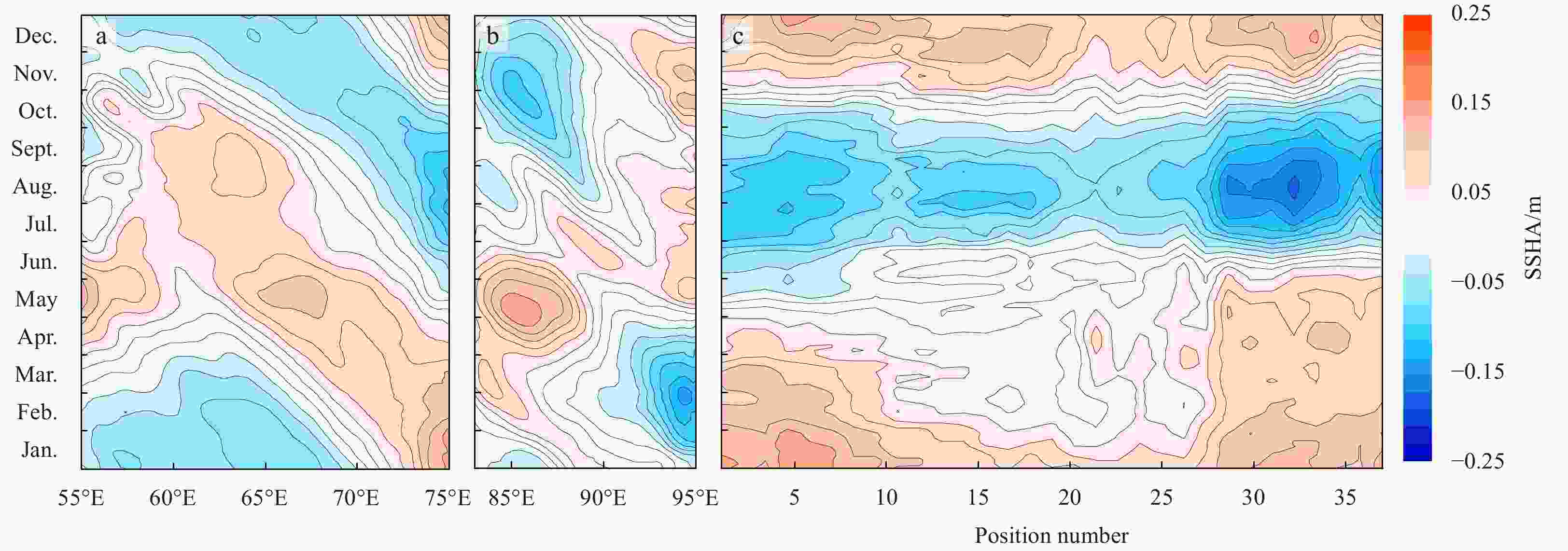Statistical characteristics and mechanisms of mesoscale eddies in the North Indian Ocean
-
Abstract: The statistical characteristics and mechanisms of mesoscale eddies in the North Indian Ocean are investigated by adopting multi-sensor satellite data from 1993 to 2019. In the Arabian Sea (AS), seasonal variation of eddy characteristics is remarkable, while the intraseasonal variability caused by planetary waves is crucial in the Bay of Bengal (BOB). Seasonal variation of the eddy kinetic energy (EKE) is distinct along the west boundary of AS, especially in the Somali Current region. In the BOB, larger EKE occurs at the northwest basin from March to May, to the east of Sri Lanka from June to September, and along the east coast of India from November to December. The wind stress work (WW) is further studied to figure out the direct influence of wind forcing on EKE. The WW exerts positive effects on EKE along the west boundary of AS and in the south of India/Sri Lanka during the two monsoon seasons. Besides, the WW also has impact on EKE along the east coast of India in November and December. Eventually, we investigate the characteristics and the driving mechanisms of long lifespan eddies. In the AS, long lifespan anti-cyclonic eddies (AEs) mainly generate in the Socotra, the West Indian Coastal Current and the East Arabian Current regions, while cyclonic eddies (CEs) are concentrated in the northwest region. In the BOB, long lifespan AEs mostly form near the west of Myanmar, while CEs are accumulated at the north and northwest basin. The instabilities caused by Rossby waves, coastal Kelvin waves, seasonal currents, together with wind stress forcing exert enormous efforts on the generation and evolution of these eddies.
-
Key words:
- mesoscale eddy /
- eddy characteristics /
- North Indian Ocean /
- satellite altimeter
-
Figure 1. Schematic currents and surface EKE in the North Indian Ocean during the summer monsoon (a) and winter monsoon (b). The abbreviations are as follows: SC, Somali Current; EAC, East Arabian Current; SMC, Southwest Monsoon Current; NMC, Northeast Monsoon Current; WICC, West India Coastal Current; EICC, East India Coastal Current; GW, Great Whirl; SE, Socotra Eddy; LH (LL), Laccadive High (Laccadive Low). The arrows sketch out the direction of currents and the color shading represents the average EKE in July (a) and January (b).
Figure 11. Horizontal distribution of monthly averaged sea surface height anomaly (SSHA). The numbers in the first subplot mark the positions correspond to the position numbers in Fig. 14b.
Figure 13. Trajectories of eddies with lifespan longer than 100 days. a–d: AEs, e–h: CEs. The square symbols denote the generated positions, and the diamond symbols refer to the dissipated positions. MAM, March, April, and May; JJA, June, July, and August; SON, September, October, and November; DJF, December, January, and February; AS, Arabian Sea; BOB, Bay of Bengal.
Figure 15. The evolution characteristics of long lifespan eddies in the North Indian Ocean. a, b and c refer to AEs generated in Regions A, B, C in diagram f; d and e refer to CEs generated in Regions D, E in diagram f. AMP, RAD, EKE, WW and EKM refer to amplitude, radius, eddy kinetic energy, the wind stress work and the Ekman pumping vertical velocity, respectively.
-
[1] Akuetevi C Q C, Barnier B, Verron J, et al. 2016. Interactions between the Somali Current eddies during the summer monsoon: Insights from a numerical study. Ocean Science, 12(1): 185–205. doi: 10.5194/os-12-185-2016 [2] Al Saafani M A, Shenoi S S C, Shankar D, et al. 2007. Westward movement of eddies into the Gulf of Aden from the Arabian Sea. Journal of Geophysical Research: Oceans, 112(C11): C11004. doi: 10.1029/2006JC004020 [3] Atlas R, Hoffman R N, Ardizzone J, et al. 2011. A cross-calibrated, multiplatform ocean surface wind velocity product for meteorological and oceanographic applications. Bulletin of the American Meteorological Society, 92(2): 157–174. doi: 10.1175/2010BAMS2946.1 [4] Babu M T, Sarma Y V B, Murty V S N, et al. 2003. On the circulation in the Bay of Bengal during northern spring inter-monsoon (March–April 1987). Deep Sea Research Part II: Topical Studies in Oceanography, 50(5): 855–865. doi: 10.1016/S0967-0645(02)00609-4 [5] Beal L M, Donohue K A. 2013. The Great Whirl: Observations of its seasonal development and interannual variability. Journal of Geophysical Research: Oceans, 118(1): 1–13. doi: 10.1029/2012JC008198 [6] Beal L M, Hormann V, Lumpkin R, et al. 2013. The response of the surface circulation of the Arabian Sea to monsoonal forcing. Journal of Physical Oceanography, 43(9): 2008–2022. doi: 10.1175/JPO-D-13-033.1 [7] Bruce J G, Johnson D R, Kindle J C. 1994. Evidence for eddy formation in the eastern Arabian Sea during the northeast monsoon. Journal of Geophysical Research: Oceans, 99(C4): 7651–7664. doi: 10.1029/94JC00035 [8] Cai Yi, Li Hai. 2011. Study on the relationship between ENSO and tropical Indian Ocean temperature. Marine Science Bulletin, 13(1): 1–9 [9] Chaigneau A, Eldin G, Dewitte B. 2009. Eddy activity in the four major upwelling systems from satellite altimetry (1992–2007). Progress in Oceanography, 83(1–4): 117–123. doi: 10.1016/j.pocean.2009.07.012 [10] Chaigneau A, Gizolme A, Grados C. 2008. Mesoscale eddies off Peru in altimeter records: Identification algorithms and eddy spatio-temporal patterns. Progress in Oceanography, 79(2–4): 106–119. doi: 10.1016/j.pocean.2008.10.013 [11] Chaigneau A, Pizarro O. 2005. Eddy characteristics in the eastern South Pacific. Journal of Geophysical Research: Oceans, 110(C6): C06005 [12] Chatterjee A, Shankar D, McCreary J P, et al. 2017. Dynamics of Andaman Sea circulation and its role in connecting the equatorial Indian Ocean to the Bay of Bengal. Journal of Geophysical Research: Oceans, 122(4): 3200–3218. doi: 10.1002/2016JC012300 [13] Chelton D. 2013. Mesoscale eddy effects. Nature Geoscience, 6(8): 594–595. doi: 10.1038/ngeo1906 [14] Chelton D B, Gaube P, Schlax M G, et al. 2011a. The influence of nonlinear mesoscale eddies on near-surface oceanic chlorophyll. Science, 334(6054): 328–332. doi: 10.1126/science.1208897 [15] Chelton D B, Schlax M G, Samelson R M. 2011b. Global observations of nonlinear mesoscale eddies. Progress in Oceanography, 91(2): 167–216. doi: 10.1016/j.pocean.2011.01.002 [16] Chen Jiajia, Cheng Xuhua, Chen Xiao. 2019. Eddy generation mechanism in the eastern South China Sea. Acta Oceanologica Sinica, 38(4): 20–28. doi: 10.1007/s13131-019-1409-3 [17] Chen Gengxin, Li Yuanlong, Xie Qiang, et al. 2018. Origins of eddy kinetic energy in the Bay of Bengal. Journal of Geophysical Research: Oceans, 123(3): 2097–2115. doi: 10.1002/2017JC013455 [18] Chen Gengxin, Wang Dongxiao, Hou Yijun. 2012. The features and interannual variability mechanism of mesoscale eddies in the Bay of Bengal. Continental Shelf Research, 47: 178–185. doi: 10.1016/j.csr.2012.07.011 [19] Cheng Xuhua, McCreary J P, Qiu Bo, et al. 2018. Dynamics of eddy generation in the Central Bay of Bengal. Journal of Geophysical Research: Oceans, 123(9): 6861–6875. doi: 10.1029/2018JC014100 [20] Cheng Xuhua, Xie Shangping, McCreary J P, et al. 2013. Intraseasonal variability of sea surface height in the Bay of Bengal. Journal of Geophysical Research: Oceans, 118(2): 816–830. doi: 10.1002/jgrc.20075 [21] Cui Wei, Yang Jungang, Ma Yi. 2016. A statistical analysis of mesoscale eddies in the Bay of Bengal from 22–year altimetry data. Acta Oceanologica Sinica, 35(11): 16–27. doi: 10.1007/s13131-016-0945-3 [22] Dandapat S, Chakraborty A. 2016. Mesoscale eddies in the western Bay of Bengal as observed from Satellite Altimetry in 1993–2014: Statistical Characteristics, variability and three-dimensional properties. IEEE Journal of Selected Topics in Applied Earth Observations and Remote Sensing, 9(11): 5044–5054. doi: 10.1109/JSTARS.2016.2585179 [23] Dong Di, Brandt P, Chang Ping, et al. 2017. Mesoscale eddies in the northwestern Pacific Ocean: Three-dimensional eddy structures and heat/salt transports. Journal of Geophysical Research: Oceans, 122(12): 9795–9813. doi: 10.1002/2017JC013303 [24] Dong Changming, McWilliams J C, Liu Yu, et al. 2014. Global heat and salt transports by eddy movement. Nature Communications, 5(1): 3294. doi: 10.1038/ncomms4294 [25] Ducet N, Le Traon P Y, Reverdin G. 2000. Global high-resolution mapping of ocean circulation from TOPEX/Poseidon and ERS-1 and -2. J. Journal of Geophysical Research: Oceans, 105(C8): 19477–19498. doi: 10.1029/2000JC900063 [26] Fischer J, Schott F, Stramma L. 1996. Currents and transports of the Great Whirl-Socotra Gyre system during the summer monsoon, August 1993. Journal of Geophysical Research: Oceans, 101(C2): 3573–3587. doi: 10.1029/95JC03617 [27] Fratantoni D M, Bower A S, Johns W E, et al. 2006. Somali Current rings in the eastern Gulf of Aden. Journal of Geophysical Research:Oceans, 111(C9): C09039 [28] Frenger I, Gruber N, Knutti R, et al. 2013. Imprint of Southern Ocean eddies on winds, clouds and rainfall. Nature Geoscience, 6(8): 608–612. doi: 10.1038/ngeo1863 [29] Geng Wu, Xie Qiang, Chen Gengxin, et al. 2016. Numerical study on the eddy−mean flow interaction between a cyclonic eddy and Kuroshio. Journal of Oceanography, 72(5): 727–745. doi: 10.1007/s10872-016-0366-0 [30] Han Weiqing, McCreary J P Jr. 2001. Modeling salinity distributions in the Indian Ocean. Journal of Geophysical Research: Oceans, 106(C1): 859–877. doi: 10.1029/2000JC000316 [31] Hu Zifeng, Tan Yehui, Song Xingyu, et al. 2014. Influence of mesoscale eddies on primary production in the South China Sea during spring inter-monsoon period. Acta Oceanologica Sinica, 33(3): 118–128. doi: 10.1007/s13131-014-0431-8 [32] Ivchenko V O, Tréguier A M, Best S E. 1997. A kinetic energy budget and internal instabilities in the Fine Resolution Antarctic Model. Journal of Physical Oceanography, 27(1): 5–22. doi: 10.1175/1520-0485(1997)027<0005:AKEBAI>2.0.CO;2 [33] Li Jiaxun, Zhang Ren, Liu Chenzhao, et al. 2012. Modeling of ocean mesoscale eddy and its application in the underwater acoustic propagation. Marina Science Bulletin, 14(1): 1–15 [34] Ma Jing, Xu Haiming, Dong Changming. 2016. Seasonal variations in atmospheric responses to oceanic eddies in the Kuroshio Extension. Tellus A: Dynamic Meteorology and Oceanography, 68(1): 31563. doi: 10.3402/tellusa.v68.31563 [35] Mason P J, Sykes R I. 1978. On the interaction of topography and Ekman boundary layer pumping in a stratified atmosphere. Quarterly Journal of the Royal Meteorological Society, 104(440): 475–490. doi: 10.1002/qj.49710444018 [36] Morrow R, Birol F, Griffin D, et al. 2004. Divergent pathways of cyclonic and anti-cyclonic ocean eddies. Geophysical Research Letters, 31(24): L24311. doi: 10.1029/2004GL020974 [37] Okubo A. 1970. Horizontal dispersion of floatable particles in the vicinity of velocity singularities such as convergences. Deep-Sea Research and Oceanographic Abstracts, 17(3): 445–454. doi: 10.1016/0011-7471(70)90059-8 [38] Penven P, Echevin V, Pasapera J, et al. 2005. Average circulation, seasonal cycle, and mesoscale dynamics of the Peru Current System: A modeling approach. Journal of Geophysical Research: Oceans, 110(C10): C10021. doi: 10.1029/2005JC002945 [39] Prasad T G, Ikeda M. 2001. Spring evolution of Arabian Sea high in the Indian Ocean. Journal of Geophysical Research: Oceans, 106(C12): 31085–31098. doi: 10.1029/2000JC000314 [40] Rao R R, Girish Kumar M S, Ravichandran M, et al. 2010. Interannual variability of Kelvin wave propagation in the wave guides of the equatorial Indian Ocean, the coastal Bay of Bengal and the southeastern Arabian Sea during 1993–2006. Deep-Sea Research Part I: Oceanographic Research Papers, 57(1): 1–13. doi: 10.1016/j.dsr.2009.10.008 [41] Sadarjoen I A, Post F H. 1999. Geometric methods for vortex extraction. In: Data Visualization’99. Vienna: Springer, 53–62 [42] Sadarjoen I A, Post F H. 2000. Detection, quantification, and tracking of vortices using streamline geometry. Computers & Graphics, 24(3): 333–341 [43] Schott F A, McCreary J P. 2001. The monsoon circulation of the Indian Ocean. Progress in Oceanography, 51(1): 1–123. doi: 10.1016/S0079-6611(01)00083-0 [44] Shankar D, Shetye S R. 1997. On the dynamics of the Lakshadweep high and low in the southeastern Arabian Sea. Journal of Geophysical Research: Oceans, 102(C6): 12551–12562. doi: 10.1029/97JC00465 [45] Shankar D, Vinayachandran P N, Unnikrishnan A S. 2002. The monsoon currents in the North Indian Ocean. Progress in Oceanography, 52(1): 63–120. doi: 10.1016/S0079-6611(02)00024-1 [46] Sreenivas P, Gnanaseelan C, Prasad K V S R. 2012. Influence of El Niño and Indian Ocean Dipole on sea level variability in the Bay of Bengal. Global and Planetary Change, 80–81: 215–225 [47] Sun Jia, Wang Guihua, Xiong Xuejun, et al. 2020. Impact of warm mesoscale eddy on tropical cyclone intensity. Acta Oceanologica Sinica, 39(8): 1–13. doi: 10.1007/s13131-020-1617-x [48] Suresh I, Vialard J, Izumo T, et al. 2016. Dominant role of winds near Sri Lanka in driving seasonal sea level variations along the west coast of India. Geophysical Research Letters, 43(13): 7028–7035. doi: 10.1002/2016GL069976 [49] Suresh I, Vialard J, Lengaigne M, et al. 2013. Origins of wind-driven intraseasonal sea level variations in the North Indian Ocean coastal waveguide. Geophysical Research Letters, 40(21): 5740–5744. doi: 10.1002/2013GL058312 [50] Tong Kai, Liu Jinfang, Yan Ming, et al. 2003. Space-time characteristic analysis of wind field over the south Indian Ocean. Marine Science Bulletin, 5(2): 5–13 [51] Trott C B, Subrahmanyam B, Chaigneau A, et al. 2018. Eddy tracking in the northwestern Indian Ocean during southwest monsoon regimes. Geophysical Research Letters, 45(13): 6594–6603. doi: 10.1029/2018GL078381 [52] Valsala V K, Rao R R. 2016. Coastal Kelvin waves and dynamics of Gulf of Aden eddies. Deep-Sea Research Part I: Oceanographic Research Papers, 116: 174–186. doi: 10.1016/j.dsr.2016.08.003 [53] Vic C, Roullet G, Carton X, et al. 2014. Mesoscale dynamics in the Arabian Sea and a focus on the Great Whirl life cycle: A numerical investigation using ROMS. Journal of Geophysical Research: Oceans, 119(9): 6422–6443. doi: 10.1002/2014JC009857 [54] Weiss J. 1991. The dynamics of enstrophy transfer in two-dimensional hydrodynamics. Physica D: Nonlinear Phenomena, 48(2−3): 273–294. doi: 10.1016/0167-2789(91)90088-Q [55] Wentz F J, Scott J, Hoffman R, et al. 2015. Remote sensing systems cross-calibrated multi-platform (CCMP) 6-hourly ocean vector wind analysis product on 0.25 deg grid, version 2.0. Santa Rosa, CA: Remote Sensing Systems [56] Willett C S, Leben R R, Lavín M F. 2006. Eddies and tropical instability waves in the eastern tropical Pacific: A review. Progress in Oceanography, 69(2−4): 218–238. doi: 10.1016/j.pocean.2006.03.010 [57] Yang Guang, Wang Fan, Li Yuanlong, et al. 2013. Mesoscale eddies in the northwestern subtropical Pacific Ocean: Statistical characteristics and three-dimensional structures. Journal of Geophysical Research: Oceans, 118(4): 1906–1925. doi: 10.1002/jgrc.20164 [58] Yang Guang, Yu Weidong, Yuan Yeli, et al. 2015. Characteristics, vertical structures, and heat/salt transports of mesoscale eddies in the southeastern tropical Indian Ocean. Journal of Geophysical Research: Oceans, 120(10): 6733–6750. doi: 10.1002/2015JC011130 [59] Zhang Zhiwei, Tian Jiwei, Qiu Bo, et al. 2016. Observed 3D structure, generation, and dissipation of oceanic mesoscale eddies in the South China Sea. Scientific Reports, 6(1): 24349. doi: 10.1038/srep24349 [60] Zhang Zhengguang, Wang Wei, Qiu Bo. 2014a. Oceanic mass transport by mesoscale eddies. Science, 345(6194): 322–324. doi: 10.1126/science.1252418 [61] Zhang Zhiwei, Zhong Yisen, Tian Jiwein, et al. 2014b. Estimation of eddy heat transport in the global ocean from Argo data. Acta Oceanologica Sinica, 33(1): 42–47. doi: 10.1007/s13131-014-0421-x [62] Zu Tingting, Wang Dongxiao, Yan Changxiang, et al. 2013. Evolution of an anticyclonic eddy southwest of Taiwan. Ocean Dynamics, 63(5): 519–531. doi: 10.1007/s10236-013-0612-6 -




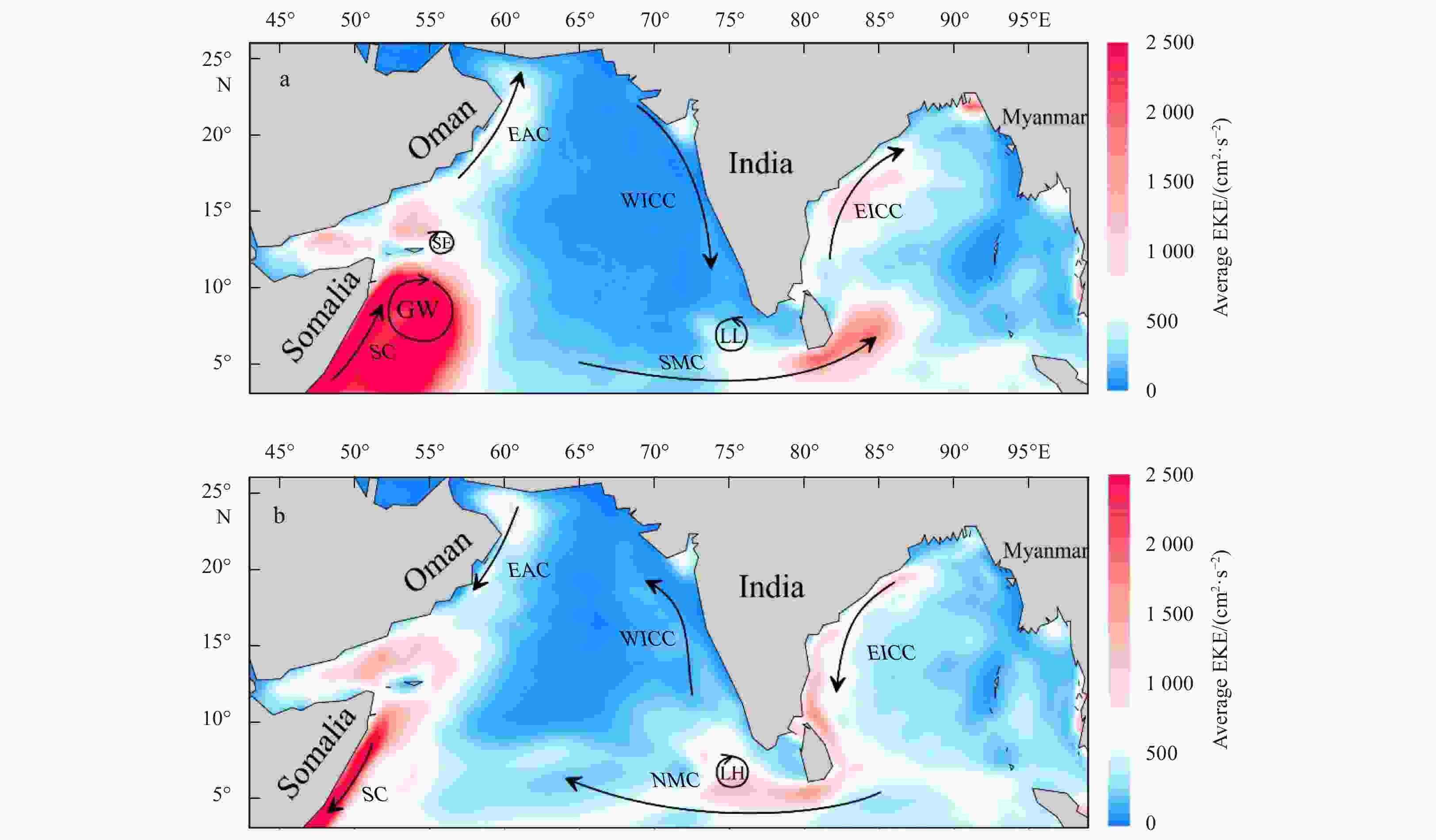
 下载:
下载:
